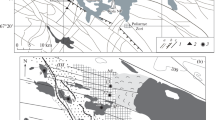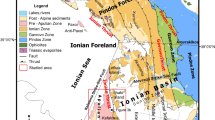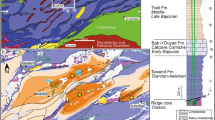Abstract
In the carbonate deposits of the upper Olenekian (Križna Nappe) and the Lower Anisian (High-Tatric Unit, Giewont Nappe) from the Tatra Mts (Western Carpathians) were recognized two sedimentary intervals containing beds with soft-sediment deformation structures (SSDS). The first interval consists of dolostones and limestones which contain following deformation structures: folds, faults, breccias and homogenized zones. The second interval is built of limestones with sigmoidally deformed veins which are interbedded with horizontally laminated limestones lacking any deformations. The deformed beds were considered as seismites on the basis of the following criteria: large lateral extent, lateral continuity of deformed sediments, vertical repetition and, morphology of SSDS comparable with structures described from earthquake–affected layers. Two other criteria necessary for recognition of seismites, i.e., the proximity to active faults and decreasing of complexity or frequency of SSDS with the increasing distance from the triggering fault are not applicable to the described succession due to Late Cretaceous tectonic movements. The presence of the described seismites does not only confirm earlier hypotheses about Anisian tectonic activity of the discussed area but also proves that the tectonic movements started already during the late Olenekian in the study area.






Similar content being viewed by others
References
Allen JRL (1982) Sedimentary structures: their character and physical basis, vol 2. Elsevier, New York, p 663
Andrusov D, Bystrický J, Fusán O (1973) Outline of the structure of the West Carpathians. Geologický Ústav Dionýza Štúra, Bratislava
Anketell JM, Cegła J, Dżułyński S (1970) On the deformational structures in systems with reversed density gradient. Ann Soc Geol Pol 40:3–30
Bac-Moszaszwili M (1995) Diversity of Neogene and Quaternary tectonic movements in the Tatra Mountains. Folia Quat 66:131–144
Bac-Moszaszwili M, Burchardt J, Głazek J, Iwanow A, Jaroszewski W, Kotański Z, Lefeld J, Mastella L, Ozimkowski W, Roniewicz P, Skupiński A, Westwalewicz-Mogilska E (1979) Geological map of the Polish Tatra Mts. 1:30 000. Wydawnictwa Geologiczne, Warszawa
Bechstädt T, Brandner R, Mostler H, Schmidt K (1978) Aborted rifting in the Triassic of the Eastern and Southern Alps. N Jahrb Geol Paläontol Abh 156:157–178
Brandner R (1984) Meeresspiegelschwankungen und Tektonik in der Trias der NW Tethys. Jahrb Geol Bund 126:435–475
Brothers RJ, Kemp AES, Maltman AJ (1996) Mechanical development of vein structures due to the passage of earthquake waves through poorly consolidated sediments. Tectonophysics 260:227–244
Dercourt J, Gaetani M, Vrielynck B, Barrier E, Biju-Duval B, Brunet MF, Cadet JP, Crasquin S, Sandulescu M (2000) Peri-Tethys Atlas palaeogeographical maps. CGMW, Paris
Dumont T, Wieczorek J, Bouillin J-P (1996) Inverted Mesozoic rift structures in the Polish Western Carpathians (High-Tatric units). Comparison with similar features in the Western Alps. Eclogae Geol Helv 89:181–202
Dżułyński S, Gradziński R (1960) Source of Lower Triassic clastics in the Tatra Mts. Bull Acad Pol Sci Cl Sci Géol Géogr 8:139–161
Einsele G, Overbeck R, Schwarz HU, Unsold G (1974) Mass physical properties, sliding and erodibility of experimentally deposited and differently consolidated clayey muds. Approach, equipment and first results. Sedimentology 21:339–372
Fijałkowska A, Uchman A (1993) New data on palynology of the Triassic of the Polish Tatra Mts. Prz Geol 41:373–375 (In Polish, English summary)
Fuglewicz R (1979) Megaspores found in the earliest Triassic deposits of the Tatra Mountains. Ann Soc Geol Pol 49:271–275
Fujiwara O (2008) Bedforms and sedimentary structures characterizing tsunami deposits. In: Shiki T, Tsuji Y, Yamazaki T, Minoura K (eds) Tsunamiites—features and implications. Elsevier, Oxford, pp 51–62
Galli P (2000) New empirical relationships between magnitude and distance for liquefaction. Tectonophysics 324:169–187
Grimm KA, Orange D (1997) Synsedimentary fracturing, fluid migration and subaqueous mass wasting: intrastratal microfractured zones in laminated diatomaceous sediments, Miocene Monterey Formation, California, USA. J Sediment Res 67:615–627
Haas J, Kovács S, Krystyn L, Lein R (1995) Significance of Late Permian-Triassic facies zones in terrane reconstructions in the Alpine−North Pannonian domain. Tectonophysics 242:19–40
Häusler H, Plašienka D, Polák M (1993) Comparison of Mesozoic succession of the Central Alps and the Central Western Carpathians. Jahrb Geol Bundesanst 136:715–739
Hips K (1998) Lower Triassic storm-dominated ramp sequence in northern Hungary: an example of evolution from homoclinal through distally steepened ramp to Middle Triassic flat-topped platform. In: Wright VP, Burchette TP (ed) Carbonate ramps, Geol Soc Lond Spec Publ 149: 315–338
Holler P (1986) Fracture activity: a possible triggering mechanism for slope instabilities in the eastern Atlantic? Geo Mar Lett 5:211–216
Jaglarz P, Rychliński T (2010) Remarks on nomenclature of Triassic carbonate rocks from the Tatra Mts. Prz Geol 58:327–334 (In Polish, English summary)
Jaglarz P, Szulc J (2003) Middle Triassic evolution of the Tatricum sedimentary basin: an attempt of sequence stratigraphy to the Wierchowa Unit in the Polish Tatra Mts. Ann Soc Geol Pol 73:169–182
Jaglarz P, Uchman A (2010) A hypersaline ichnoassemblage from the Middle Triassic carbonate ramp of the Tatricum domain in the Tatra Mountains, Southern Poland. Palaeogeogr Palaeoclimat Palaeoecol 292:71–81
Jewell HE, Ettensohn FR (2004) An ancient seismite response to Taconian far-field forces: the Cane Run Bed, Upper Ordovician (Trenton) Lexington Limestone, Central Kentucky (USA). J Geodyn 37:487–511
Jurewicz E (2005) Geodynamic evolution of the Tatra Mts. and the Pieniny Klippen Belt (Western Carpathians): problems and comments. Acta Geol Pol 55:295–338
Kahle CF (2002) Seismogenic deformation structures in microbialites and mudstones, Silurian Lockport Dolomite, Northwestern Ohio. J Sediment Res 72:201–216
Kimura G, Koga K, Fuijoka K (1989) Deformed soft sediments as the junction between the Marina and Yap Trenches. J Struct Geol 11:463–472
Kotański Z (1956) High-tatric Campillian in the Tatra Mts. Acta Geol Pol 6:65–73 (in Polish)
Kotański Z (1961) Tectogenese et reconstitution de la paleogeographie de la zone haut-tatrique dans les tatras. Acta Geol Pol 11:186–476 (in Polish, French summary)
Kotański Z (1963) Stratigraphie et lithologie du Trias Subtatrique de la region de Zakopane. Acta Geol Pol 13:317–385 (in Polish, French summary)
Kotański Z (1979) The position of the Tara Mountains in the Western Carpathians. Prz Geol 27:359–369 (in Polish, English summary)
Kovács S (1984) North Hungarian Triassic facies types: a review. Acta Geol Hung 27:251–264
Kozur H (1991) The evolution of the Meliata-Hallstatt ocean and its significance for early evolution of the Eastern Alps and Western Carpathians. Palaeogeogr Palaeoclimat Palaeoecol 87:109–135
Kozur H, Mock R (1997) New paleogeographic and tectonic interpretations in the Slovakian Carpathians and their implications for correlations with the Eastern Alps and other parts of the Western Tethys. Part II: inner Western Carpathians. Miner Slovaca 29:164–209
Lefeld J, Gaździcki A, Iwanow A, Krajewski K, Wójcik K (1985) Jurassic and Cretaceous lithostratigraphic units in the Tatra Mountains. Stud Geol Polon 84:1–93
Lein R (1987) Evolution of the Northern Calcareous Alps during Triassic times. In: Flügel HW, Faupl P (eds) Geodynamic of the Eastern Alps. Deuticke, Vienna, pp 85–102
Leszczyński S, Pszonka J (2014) Skały klastyczne triasu dolnego (?ind–olenek dolny). In: Jach R, Rychliński T, Uchman A (ed) Skały osadowe Tatr, Tatrzański Park Narodowy − Wydawnictwa, Zakopane, pp 34–41 (In Polish)
Martín-Chivelet J, Palma RM, López-Gómez J, Kietzmann DA (2011) Earthquake-induced soft-sediment deformation structures in Upper Jurassic open-marine microbialites (Neuquén Basin, Argentina). Sediment Geol 235:210–221
Michalík J (1979) Slumping in the Hronic unit (Choč Nappe) of the Western Carpathians at the Anisian/Ladinian boundary. Miner Slovaca 11:299–309
Michalík J (1993) Mesozoic tensional basin in the Alpine-Carpathian shelf. Acta Geol Hung 36:395–403
Michalík J (1994) Notes on the paleogeography and paleotectonics of the Western Carpathians area during the Mesozoic. Mitt Österreichischen Geol Ges 86:101–110
Michalík J (1997) Tsunamites in a storm-dominated Anisian carbonate ramp (Vysoka Formation, Male Karpaty Mts., Western Carpathians). Geol Carpath 48:221–229
Michalík J, Soták J (1997) Stop 3, Mt Muráň section above the Javorová Valley (High Tatra Mts.). Miner Slovaca 29:360–363
Michalík J, Masaryk P, Lintnerová O, Papšová J, Jendrejáková O, Reháková D (1992) Sedimentology and facies of a storm-dominated Middle Triassic carbonate ramp (Vysoká Formations, Malé Karpaty Mts., Western Carpathians). Geol Carpath 43:213–230
Monaco P (1992) Hummocky cross-stratified deposits and turbidites in some sequences of the Umbria-Marche area (central Italy) during Toarcian. Sediment Geol 77:123–142
Moretti M, Ronchi A (2011) Liquefaction features interpreted as seismites in the Pleistocene fluvio-lacustrine deposits of the Neuquén Basin (Northern Patagonia). Sed Geol 235:200–209
Moretti M, Van Loon AJ (2014) Restrictions to the application of ‘diagnostic’ criteria for recognizing ancient seismites. J Palaeogeogr 3:162–173
Myrow PM, Southard JB (1996) Tempestite deposition. J Sediment Res 66:875–887
Nehyba S (2014) Soft-sediment deformation structures in Lower Badenian (Middle Miocene) foreshore sands and their trigger mechanism (Carpathian Foredeep Basin, Czech Republic). Austrian J of Earth Sc 107:23–36
Neuweiler F, Peckmann J, Ziems A (1999) Sinusoidally deformed veins (“Sigmoidalklüftung”) in the Lower Muschelkalk (Triassic, Anisian) of Central Germany: sheet injection structures deformed within shallow subsurface. Neues Jahrb Geol Paläontol Abh 214:129–148
Obermeier SF (2009) Using liquefaction-induced and other soft-sediment features for paleoseismic analysis. In: McCalpin JP (ed) Paleoseismology. Academic Press, London, pp 497–564
Onasch CM, Kahle CF (2002) Seismically induced soft-sediment deformation in some Silurian carbonates, eastern US. Midcontinent. In: Ettensohn FR, Rast N, Brett CE (ed) Ancient seismites, Geol S Am S 359 pp 165–176
Owen G (1987) Deformation processes in unconsolidated sands. In: Jones ME, Preston RMF (eds) Deformation of sediments and sedimentary rocks, Geol Soc Lon Spec Publ 29, pp 11–24
Owen G, Moretti M (2011) Identifying triggers for liquefaction-induced soft-sediment deformation in sands. Sediment Geol 235:141–147
Papadopoulos GA, Lefkopoulos G (1993) Magnitude-distance relation for liquefaction in soil from earthquakes. B Seismol Soc Am 83:925–938
Passendorfer E (1959) Eocene palaeogeography of the Tatra Island. Biuletyn Instytutu Geologicznego 149:259–271 (In Polish, English summary)
Pickering KT, Agar SM, Prior DJ (1990) Vein structure and the role of pore fluids in early deformation of Late Miocene volcaniclastics, Miura Group, SE Japan. In: Knipe RJ, Rutter EH (ed) Deformation Mechanisms, Rheology and Tectonics, Geol Soc Lond Spec Publ 54: pp 417–430
Reid RP, Visscher PT, Decho AW, Stolz JF, Bebout BM, Dupraz C, Macintyre IG, Paerl HW, Pinckney JL, Prufert-Bebout L, Steppe TF, DesMarais DJ (2000) The role of microbes in accretion, lamination and early lithification of modern marine stromatolites. Nature 406:989–992
Rychliński T (2008) Evolution of the Fatricum basin in late Olenekian–Norian time in the Tatra Mts. Dissertation. Jagiellonian University, Kraków (In Polish, English summary)
Rychliński T (2014) Skały węglanowe i klastyczne triasu dolnego (ind–olenek). In: Jach R, Rychliński T, Uchman A (ed) Skały osadowe Tatr, Tatrzański Park Narodowy−Wydawnictwa, Zakopane, pp 118–123 (In Polish)
Rychliński T, Szulc J (2005) Facies and sedimentary environments of the Upper Scythian–Carnian succession from the Belanské Tatra Mts., Slovakia. Ann Soc Geol Pol 75:155–169
Schlager W, Schöllnberger W (1974) Das Prinzip stratigraphicher Wende in der Schichtfolge der Nördlichen Kalkalpen. Mitt Österreichischen Geol Ges 66(67):165–193
Schwarz HU (1975) Sedimentary structures and facies analysis of shallow marine carbonates (Lower Muschelkalk, Middle Triassic, Southwestern Germany). Contrib Sedimentol 3:1–100
Seilacher A (1969) Fault-graded beds interpreted as seismites. Sedimentology 13:155–159
Spalluto L, Moretti M, Festa V, Tropeano M (2007) Seismically-induced slumps in Lower-Maastrichtian peritidal carbonates of the Apulian Platform (southern Italy). Sediment Geol 196:81–98
Van Loon AJ, Pisarska-Jamroży M (2014) Sedimentological evidence of Pleistocene earthquakes in NW Poland induced by glacio-isostatic rebound. Sediment Geol 300:1–14
Wieczorek J (2000) Mesozoic evolution of the Tatra Mountains (Carpathians). Mitt Ges Geol Bergbaustud Wien 44:241–262
Acknowledgements
The authors are grateful to A. J. (T) Van Loon for inspiring ideas and valuable suggestions improving the present version of the manuscript and to Alfred Uchman for the language improvement. The authors are indebted to anonymous reviewer for the critical comments. The authors are also grateful to the managements of the Tatra National Park (Poland) for providing the permission for fieldwork. The investigations were supported by the Jagiellonian Uniwersity (DS funds).
Author information
Authors and Affiliations
Corresponding author
Rights and permissions
About this article
Cite this article
Rychliński, T., Jaglarz, P. An evidence of tectonic activity in the Triassic of the Western Tethys: a case study from the carbonate succession in the Tatra Mountains (S Poland). Carbonates Evaporites 32, 103–116 (2017). https://doi.org/10.1007/s13146-016-0327-0
Accepted:
Published:
Issue Date:
DOI: https://doi.org/10.1007/s13146-016-0327-0




